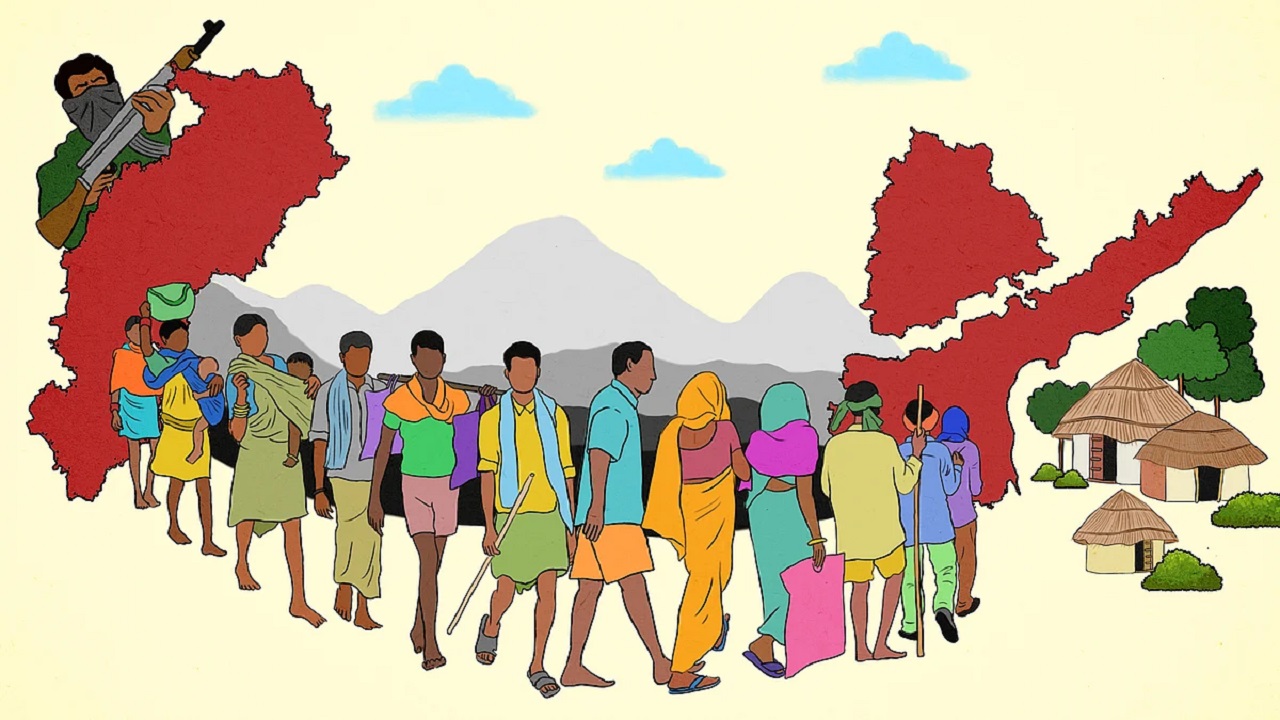Tribal Displacement in India: Causes, Challenges, and the Way Forward
Context:
The National Commission for Scheduled Tribes (NCST) has recently ordered a thorough survey to assess the condition of displaced tribal communities in the states of Andhra Pradesh, Telangana, and Chhattisgarh. These states have seen significant tribal displacement due to a combination of security issues, developmental projects, political conflicts, and ecological disasters. The plight of these tribals has been exacerbated by a lack of cohesive policies and effective rehabilitation measures.
Causes of Tribal Displacement:
-
Security Concerns:
-
Left-wing extremism and insurgency have been significant contributors to tribal displacement.
-
For instance, around 50,000 tribals were displaced from Chhattisgarh due to Maoist violence.
-
-
Developmental Projects:
-
Infrastructure projects, such as dams, highways, and power plants, often require the displacement of tribal populations.
-
The construction of the Sardar Sarovar Dam on the Narmada River displaced over 41,000 families across Gujarat, Maharashtra, and Madhya Pradesh.
-
-
Political Conflicts:
-
Tribal communities are often caught in the crossfire of ethnic tensions, insurgencies, and border disputes.
-
States like Nagaland, Assam, and Mizoram have experienced tribal displacement due to insurgency-related violence.
-
For example, clashes between Bodo and other communities in Assam led to the displacement of thousands.
-
-
Ecological Disasters:
-
Natural disasters such as floods, droughts, and cyclones displace tribal communities from their traditional lands.
-
The Mishing community in Majuli Island, Assam has faced repeated displacement due to river erosion.
-
The Strategic Hamlet Program in India:
The Strategic Hamlet Program was introduced as a counterinsurgency tactic aimed at isolating tribal communities from insurgents by relocating them into fortified settlements. The effectiveness of this program has varied across regions.
-
Telangana:
-
In 1949, after the Nizam’s surrender, the Indian government relocated tribals from forests into roadside camps to combat the Telangana communist movement.
-
Tribals were also recruited as Special Police Constables to fight the communist rebels. One notable group was the Tiger Squad, consisting of around 300 Koya tribals.
-
-
Chhattisgarh:
-
In 2005, the government initiated a Strategic Hamleting program, relocating 50,000 Gond tribals to camps in Andhra Pradesh (now part of Telangana) to counter Maoist insurgents.
-
Many tribals later returned to their forest homes, but some were unable to do so due to threats from Maoists and instead joined security forces.
-
-
Mizoram:
-
In the 1960s, the Strategic Hamlet Program was more successful in Mizoram, where the government reached a peace agreement with the Mizo insurgents.
-
-
Bru Displacement:
-
In 2019, Bru (Reang) tribals were displaced due to ethnic violence with Mizo tribals in Mizoram, leading to their migration to Tripura.
-
Challenges Faced by Displaced Tribals:
-
Absence of National Policy:
-
There is no specific national or international policy for Internally Displaced Persons (IDPs), leading to ineffective rehabilitation and resettlement.
-
-
Harassment and Exploitation:
-
Displaced tribals often face harassment from forest officials, police, and even local residents who view them as encroachers.
-
-
Security Threats:
-
Many tribals, especially in Maoist-affected regions, are unable to return to their ancestral homes due to the ongoing security threat from armed groups.
-
-
Lack of Legal Recognition:
-
States like Andhra Pradesh and Telangana have not officially recognized many displaced tribals as Scheduled Tribes, thus denying them state support and benefits.
-
For example, the Gutti Koya tribals in these regions have been denied tribal status, being treated as migrants instead.
-
-
Non-Allocation of Alternative Land:
-
According to the Forest Rights Act (2006), the government must provide alternative land to tribals displaced from forest areas. However, this provision has not been effectively implemented in Andhra Pradesh, Telangana, and Chhattisgarh.
-
-
Inadequate Compensation:
-
Many displaced families do not receive adequate compensation under the Right to Fair Compensation and Transparency in Land Acquisition, Rehabilitation and Resettlement Act (2013).
-
-
Regressive State Actions:
-
In some states, like Telangana, the government has seized tribal lands for afforestation projects, while Andhra Pradesh has destroyed houses built by displaced tribals in forested areas to prevent settlement.
-
-
Poor Inter-State Cooperation:
-
States often fail to cooperate on the rehabilitation of displaced tribes, leading to further hardship for these communities.
-
The Way Forward:
-
National Policy on IDPs:
-
A dedicated national policy for Internally Displaced Tribals should be formulated to establish clear guidelines for inter-state cooperation and the protection of tribal rights.
-
-
Amendment of Existing Laws:
-
Existing laws like the Forest Rights Act (2006) and the Land Acquisition Act (2013) must be amended and strictly enforced to ensure that displaced tribals are adequately compensated and resettled.
-
-
Provision of Alternative Land:
-
Displaced tribals should be provided with alternative land with proper infrastructure, ensuring their sustainable livelihood.
-
-
Protection of Political and Social Rights:
-
The political and social rights of displaced tribals should be respected in both their new settlements and original homelands to ensure their full reintegration into society.
-


.png)
_(9).jpg)
Comments (0)